"How do we explain occurrences that don't easily fit our everyday understandings of how things work?"
So much of the human progress over our species' existence has been to gain and codify knowledge into a technology continuum we manipulate with embarrassingly little skill and even less appreciation.
But equally (and I proclaim, more beautifully), there has been a more imaginative, less linear progression of imagination and creation: lore and beliefs that make sense of things that do not (yet) make sense. "Science is not the only way to arrive at knowledge," confessed physicist Alan Lightman in his quest to unpack the uncertainties of the universe. So much of our cultural creativity stems from a need to fold the uncertain into humanity. The invention of gods, spirits, myths, and legends forms more than cultural bedrock; it lightens and warms the dark.
In the rich, frequently oral tradition of Japanese folklore, there is a tumult of creatures called yōkai (妖怪, "strange apparition"), which have come into being over hundreds of years of imaginative ebbs. In 2015, Japanese scholar Michael Dylan Foster collected these wildly ephemeral and highly uncodified spirits. He rendered them in a collective of love: The Book of Yōkai: Mysterious Creatures of Japanese Folklore.
Such as the feeling of being connected and known to the tree's spirit, kodama.
Kodama - Tree Spirit
Trees are prominent landscape features throughout Japan; large, unusual, or old trees are often considered sacred. In shrines throughout the country, it is common to see a shimenawa rope draped around the trunk of ancient trees, indicating a divine connection. […] The kodama, "tree spirit," is not set in behavior or appearance. [...] In Japanese, the word kodama also means "echo." This usage may be directly linked to the yokai Kodama—from a belief that an echo is the spirit of the woods responding to a call.
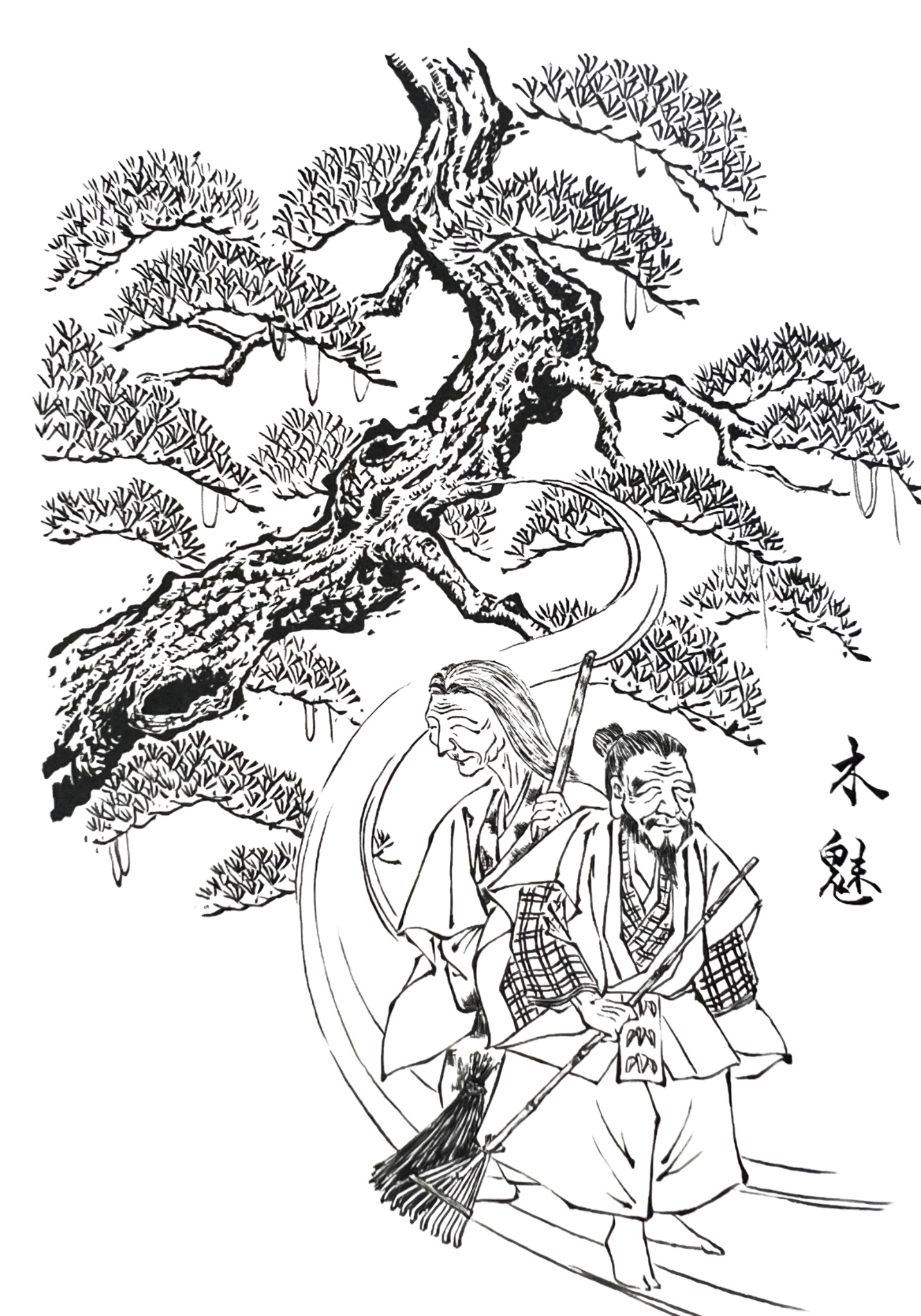 Kodama, the yōkai meaning "tree spirit."
Kodama, the yōkai meaning "tree spirit."Or their very own version of a human-fish hybrid, the mummified remains of which can still be found today (undoubtedly handmade during the Edo period consisting of parts from a fish and a monkey.)
Ningyo - Mermaid or Merman
The size, shape, and countenance of ningyo vary. Generally the upper body of the creature - sometimes just the head, sometimes the arms as well-is humanlike, while the lower body is fishlike. The inverse has also been found on occasion. In many Edo-period illustrations, ningyo also have horns protruding from their otherwise humanlike heads.
One of the most famous yōkai is the kappa, associated with water and rivers and cruelly murderous.
Kappa - Lake/Pond creatures
Different legends and beliefs about it are distributed throughout the country, but generally speaking, the kappa is considered scaly or slimy, greenish in color, with webbed feet and hands, and a carapace on its back. Sometimes it resembles a monkey, and sometimes a giant frog or turtle. It is the size of a young child but disproportionately strong. A concave indentation or saucer on top of the kappa's strength. Kappas are mischievous and sometimes deadly, notorious for pulling horses and cattle into the water; they have also been known to drown young children and extract their internal organs through their anuses.
Many fantastic beasts collected, invented, and handed down over generations embody familiar, universal phenomena from natural physical occurrences. Like the yamabiko spirit that hollers back when one shouts into a mountain. Is the yamabiko there waiting even now, ready to respond? Does the spirit exist when we are not shouting into mountains?
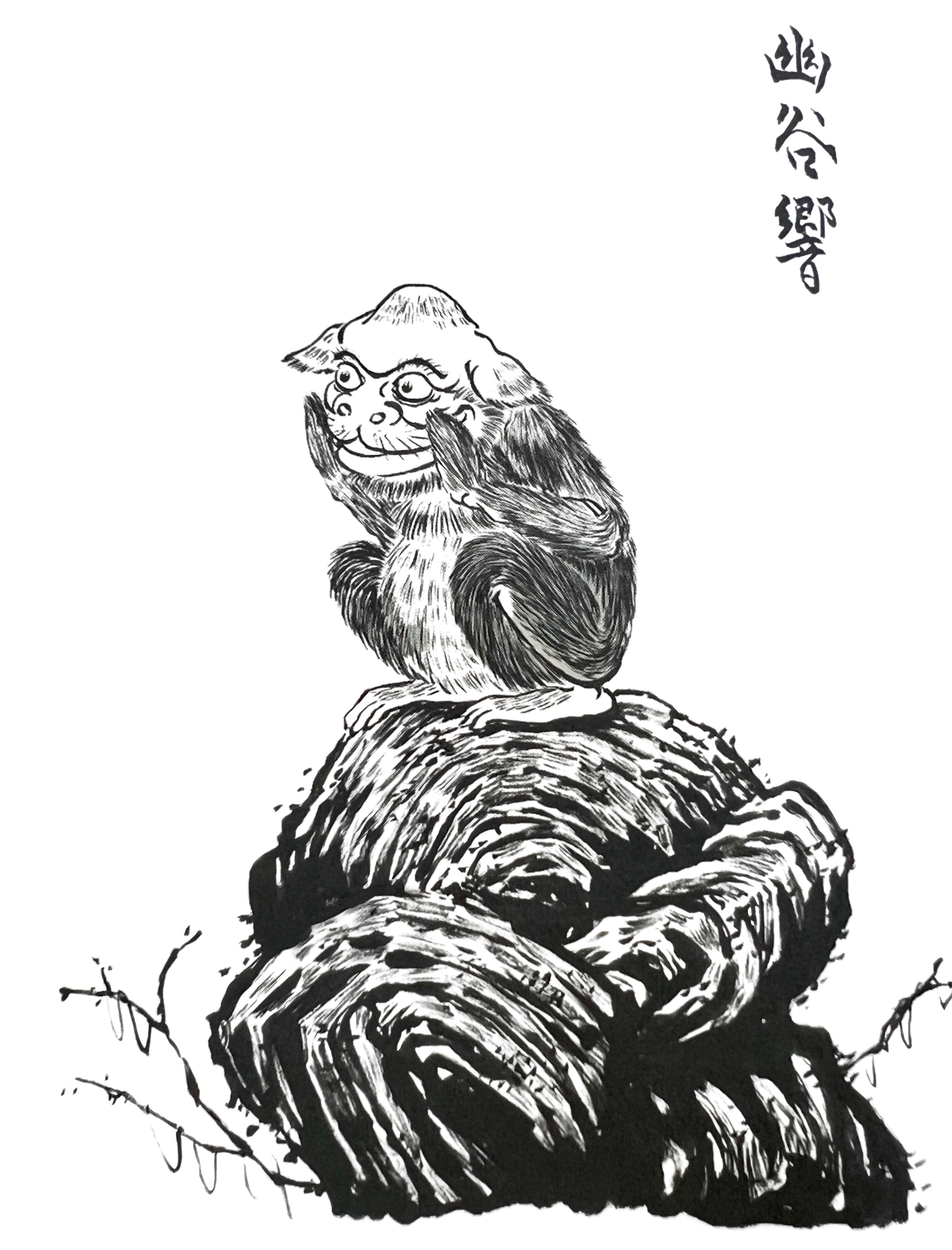 Yamabiko, the yōkai meaning "echo."
Yamabiko, the yōkai meaning "echo."Many yōkai are uniquely cultural to Japan; tengu is a mountain goblin associated with Buddhism and mountain aesthetics, or karasu tengu, a crow associated with mountain worship known for "spiriting away" children.
Karasu Tengu - Mountain Crow
A birdlike creature with wings, beaked mouth, and the ability to fly. Despite the word crow, karasu tengu are often portrayed as birds of prey, particularly tonbi (kites). During the Edo period, the karasu tengu was gradually supplanted by a more humanlike creature - tall dressed like a Buddhist monk or other religious practitioners, and featuring a long, bulbous, red nose. This long-nosed tengu is the version most commonly depicted in Japanese culture today.
[...]
They were often invoked as an explanation for mysterious happenings. The sound of a tree falling in the forest, for example, might be attributed to the machinations of a tengu. Other times, the tengu might cause real mischief. In a certain location in Gifu City, for example, it was said that a tengu made his home in a large pine tree. If a fisherman wanted to go fishing nearby, the tengu would throw rocks at him to get him to reconsider.
Most famously and frighteningly, tengu were often the perpetrators of something called kamikakushi: kidnapping by a god, translatable as "spiriting away," or more literally, "hiding by a deity."
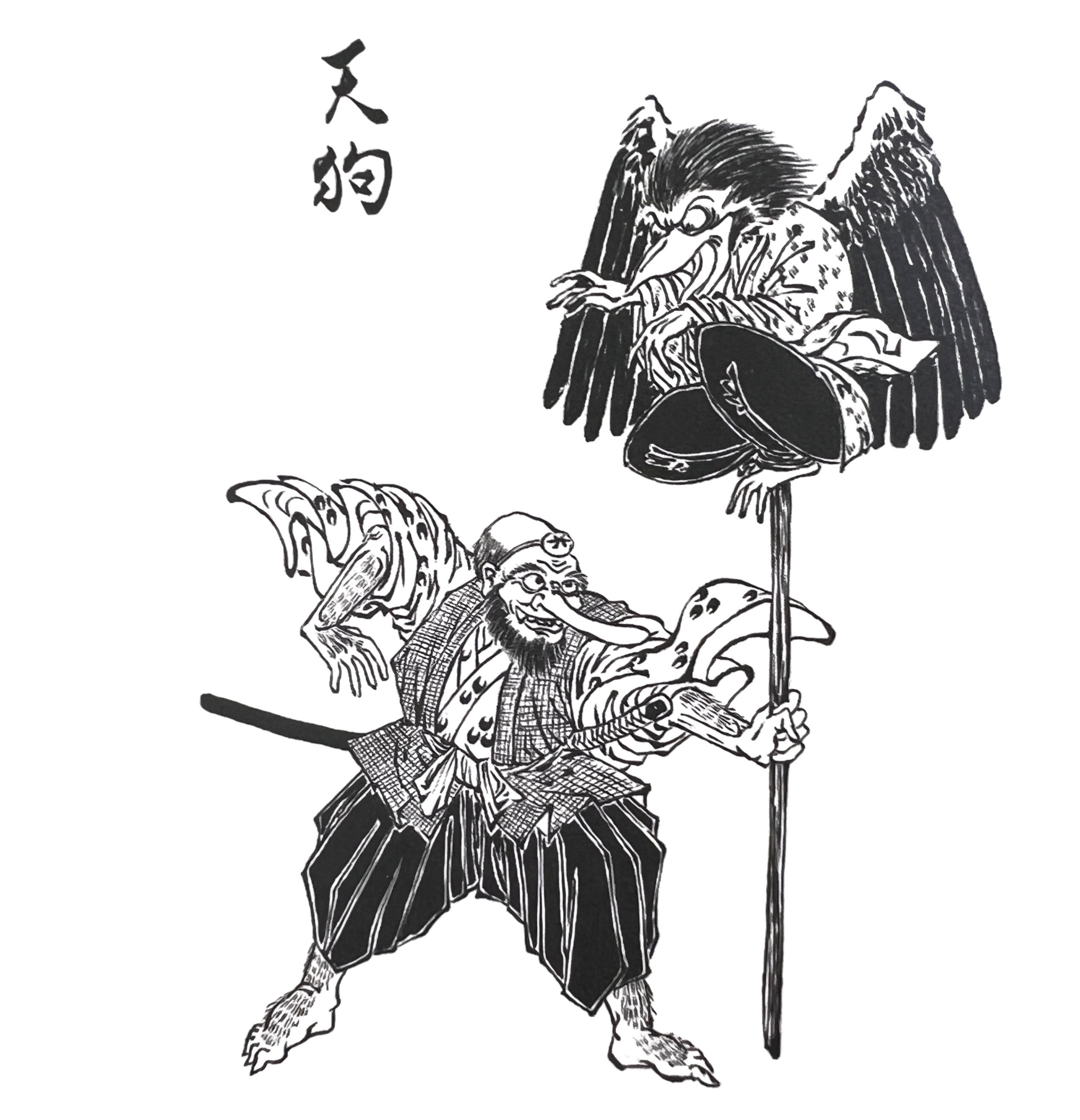 Daitengu and kotengu (also known as karasu tengu).
Daitengu and kotengu (also known as karasu tengu).My favorite yōkai, which felt unknowable at first and then fell into perfect sense, is nurikabe, a plaster wall that appears when one is exhausted with physical strain. Who hasn't suffered such a psychosomatic imposition? Yōkai creatures frequently represent physical afflictions, although many are not ones we would immediately understand.
Kamaitachi - Sickle Weasel
You are walking outside and suddenly discover that your leg has been cut as if with a sharp blade. This is said to be the work of a kamaitachi. Literally a "sickle weasel." the kamaitachi is an extremely widespread yokai phenomenon found throughout Japan, but probably most common in the so-called snow country of northern Honshu. In most cases, the creature inflicts its wound on the lower part of the body, on the shin or the calf, and often there is no blood associated with the cut. Beliefs and narratives about kamaitachi vary from place to place, but the creature is usually said to ride in with a powerful gust of wind or on a whirlwind; in some places, the phenomenon is known as kamakaze, or "sickle wind."
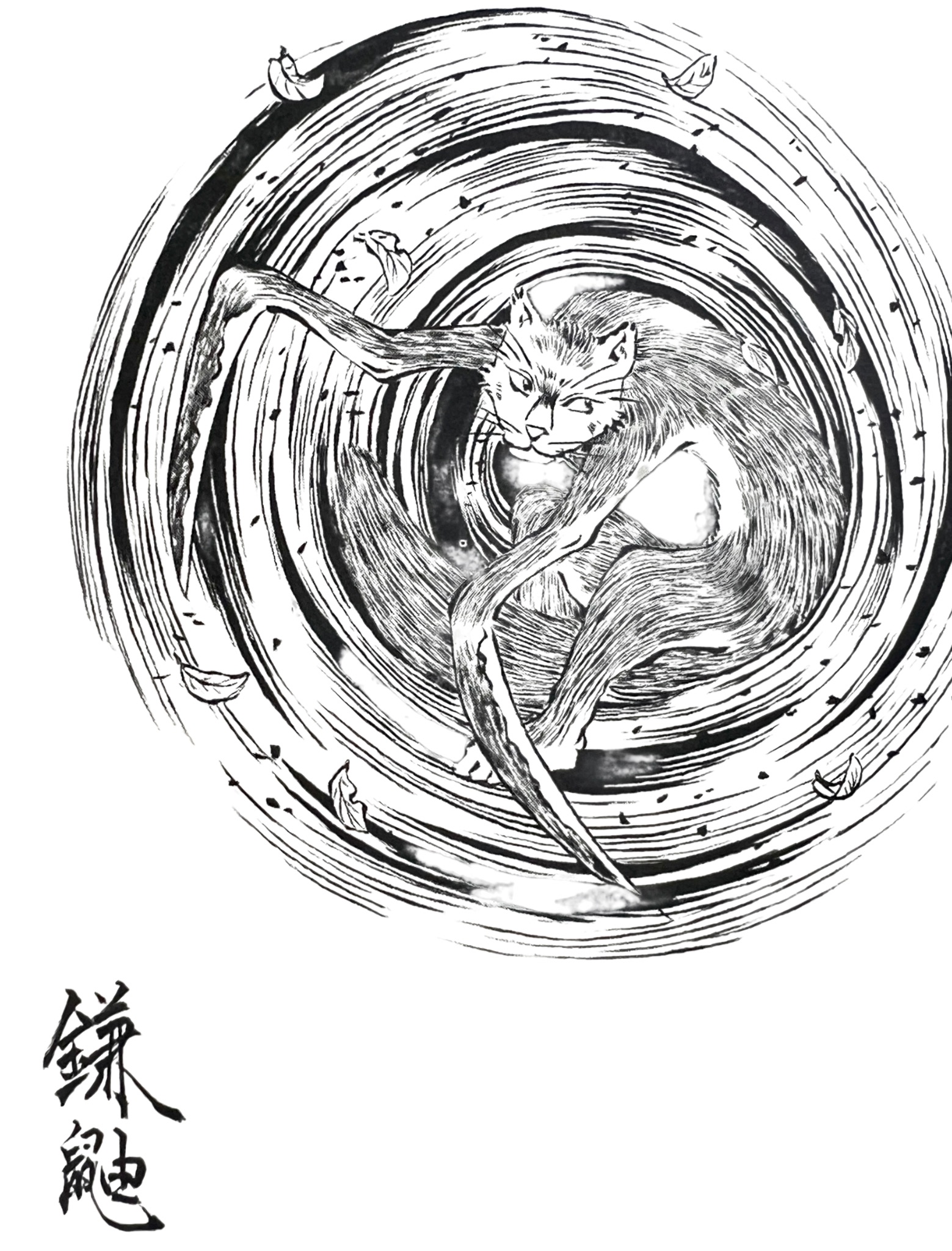 Kamaitachi, a yōkai meaning "sickle weasel."
Kamaitachi, a yōkai meaning "sickle weasel."The yōkai are dangerous and mischievous, kind, and very frequently playful. Like most cultural remnants, they vary depending on geography and period and are only loosely coordinated from one region to the next.
Tsuchigumo - Earth Spider
The word tsuchigumo, which literally means "earth spider," appears in the [...] mytho-historical texts and seems to have been used as a derogatory and demonizing label for the indigenous inhabitants of Japan. That is, the people writing the texts used the term to negatively describe the natives they were conquering; they portrayed them as having short bodies and long arms and legs and as living in holes in the ground.
 This exquisite outer kimono (uchikake) is from the Japanese Edo period and was made around 1870 to 90. With silk and metal-covered thread, it depicts scenes from well-known kabuki plays, which included yōkai characters. Learn more.
This exquisite outer kimono (uchikake) is from the Japanese Edo period and was made around 1870 to 90. With silk and metal-covered thread, it depicts scenes from well-known kabuki plays, which included yōkai characters. Learn more.In 1943, children's book author Roald Dahl published a short story about mischievous creatures, "gremlins," that haunted the Royal Air Force fleet and caused frequent and inexplicable mechanical failings (Dahl wrote he barely lived through such an incident himself.) The story turned Dahl into a full-time author almost overnight and was made into an eponymous film in the 1980s. Almost unthinkingly, we create stories and characters to turn experience into knowledge. In this era of overbearing technology, do we still imagine that which does not exist?
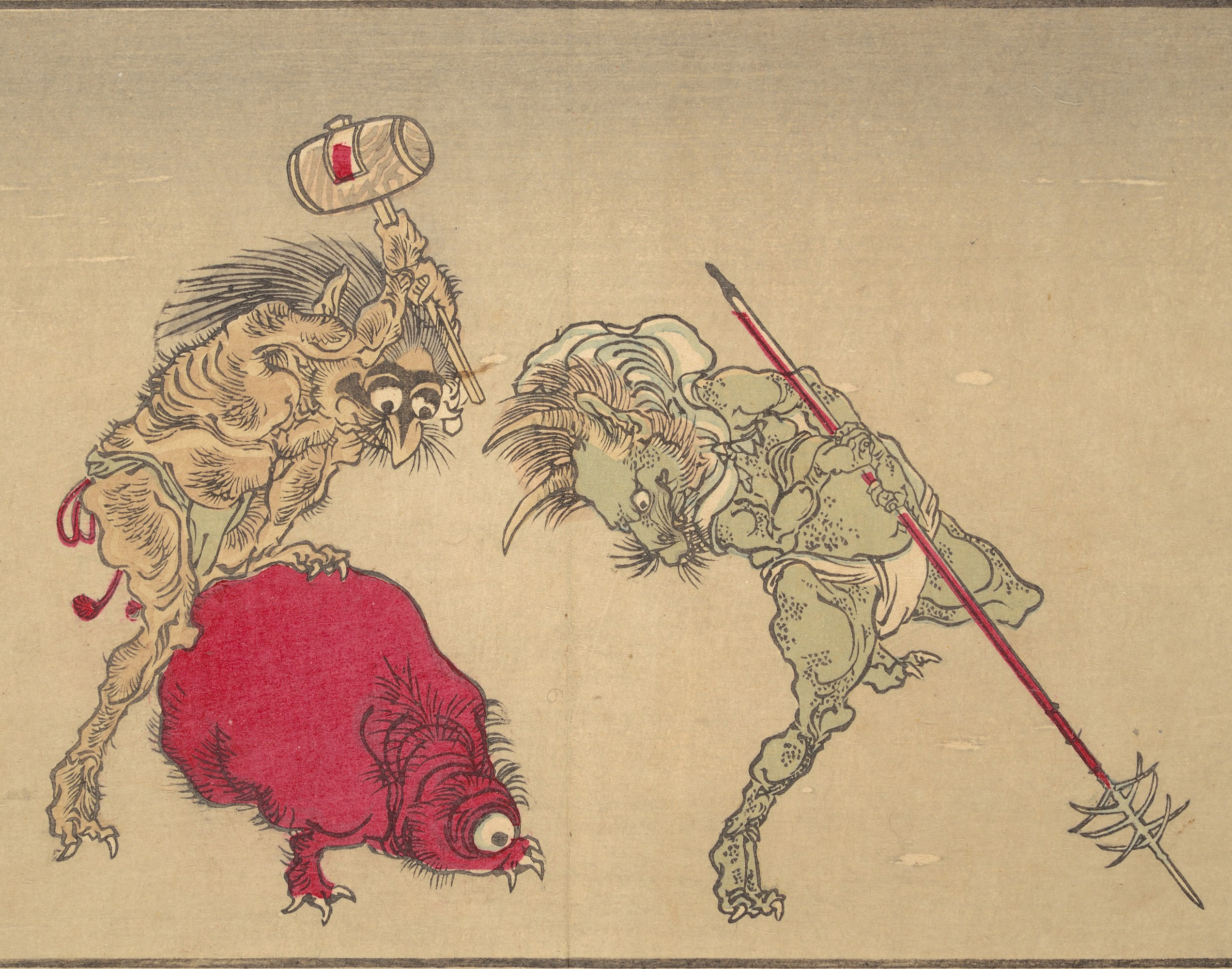 A Yokai illustration from Pictures of One Hundred Demons by 1900th-century illustrator and print artist Kyōsai Kawanabe (河鍋 暁斎).
A Yokai illustration from Pictures of One Hundred Demons by 1900th-century illustrator and print artist Kyōsai Kawanabe (河鍋 暁斎).As we illuminate more of our shadowy world and our shadowed selves with science—why the sky is blue, why echoes exist, why we feel something is watching us, why we can't shake deep melancholy—I hope there will always be room for spirits, for magic, for creativity. The Book of Yōkai is a testament to human invention, combined with the illustrations of contemporary Japanese artist Shinonome Kijin.
"There is a kind of lazy pleasure in useless and out-of-the-way erudition," confessed Jorge Luis Borges in his vast and enriching bestiary of imaginary beings. But when we step into the lore of the past, we are more than collecting erudition; we are carrying on the traditions and frequently finding answers ourselves. Foster writes:
One common characteristic of Yōkai is their liminality, or "in-betweenness." They are creatures of the borderlands, living on the edge of town, or in the mountains between villages, or in the eddies of a river running between two rice fields. They often appear at twilight, that gray time when the familiar seems strange and faces become indistinguishable. They lurk at crossroads.
Many experiences lack the appropriate language to feel whole, especially in the realm of feelings and emotions, like a deep longing for the impossible, a sense of alienation when we return to places we once loved, or the fickleness of spring. A primary focus of The Examined Life is to pull those feelings together and present them, to try to make sense of the unspeakable things that make us human.


